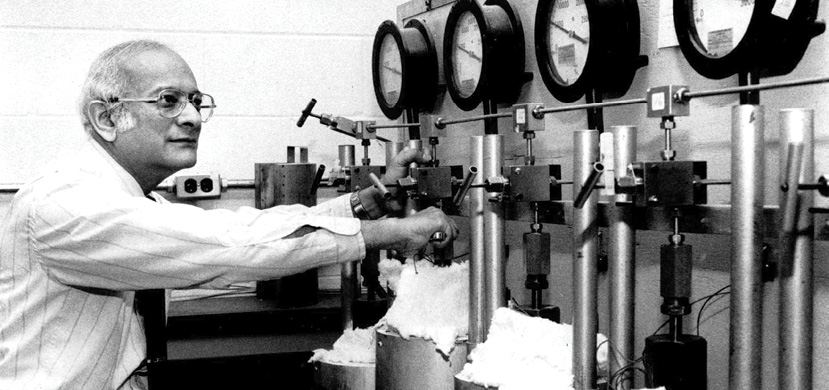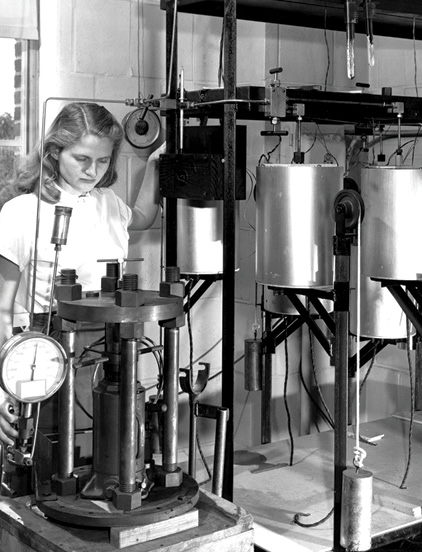
Award keeps the Roys' legacy of interdisciplinary innovation alive
Two of Penn State's most impactful materials researchers were a married couple: the late Rustum and Della Roy. Their collaborative efforts and individual achievements have played a pivotal role in advancing materials science, fostering interdisciplinary collaborations, and inspiring future generations of scientists. Part of this inspiration is an annual award that helps shape the future of materials research at Penn State.
The Rustum and Della Roy Innovation in Materials Research Award is presented by the Materials Research Institute (MRI) and recognizes recent interdisciplinary materials research at Penn State that yields innovative and unexpected results. The award covers a wide range of research with societal impact and includes three categories: Early Career Faculty, Non-Tenure Faculty, and Research Staff, and Graduate Student. It exists thanks to a gift from Della and Rustum.
Della and Rustum were alumni of Penn State’s College of Earth and Mineral Sciences and were long-serving faculty in the college. Rustum served for more than 50 years as an Evan Pugh Professor of the Solid State, professor of geochemistry, and professor of science, technology, and society. He gained a global reputation as a pioneer in interdisciplinary research. This included the nation’s first Graduate Interdisciplinary Degree Program in Solid State Technology (now known as materials research), the first independent interdisciplinary Materials Research Laboratory (later became the Materials Research Institute), and the first undergraduate program in Science, Technology, and Society. He also founded two major national societies in these fields of research, including the Materials Research Society.
“He was always full of new ideas, new approaches, and most importantly he was a diehard optimist,” said Dinesh Agrawal, professor emeritus who worked with the Roys. “His eternal message was: Think positive, be persistent in your pursuit and you will attain success. He would always find something good or positive out of a hopeless situation or any seemingly failed experiment. He would always give you a sense of hope. Also, he was a workaholic, working almost 16 hours a day. His work-efficiency with alarming speed was amazing, he would be doing 10 things at the same time with quiet ease; even a man of 40 years old would not do that much work in one day what he was doing even when he was 85.”
 Part of Rustum’s legacy is how effective interdisciplinary research has become at Penn State. In December 2019, a research team led by Steve Brint of the University of California, Riverside published an article in The Journal of Higher Education that evaluated the effectiveness of interdisciplinary research and cluster hiring at 20 universities; the study revealed that despite recruiting top experts in the field, interdisciplinary research was having difficulty taking hold. The study noted that “There are exceptions to this rule. One university in our sample stood out," which was Penn State.
Part of Rustum’s legacy is how effective interdisciplinary research has become at Penn State. In December 2019, a research team led by Steve Brint of the University of California, Riverside published an article in The Journal of Higher Education that evaluated the effectiveness of interdisciplinary research and cluster hiring at 20 universities; the study revealed that despite recruiting top experts in the field, interdisciplinary research was having difficulty taking hold. The study noted that “There are exceptions to this rule. One university in our sample stood out," which was Penn State.
During his graduate work, Rustum met Della as they shared an office and lab. Their relationship grew and they married in June 1948, a marriage that spanned 62 years until Rustum’s death in 2010. She became renowned as a leader in the world of cement and concrete, known for her work in advanced concrete materials for pavements, chemically bonded cements, ancient cement-based building materials, and high-temperature cements for geothermal wells. Della proved to be an inspiration to female scientists, as her work resulted in a series of pioneering moments for women in STEM. The mineral dellaite was named after her in 1965. She is one of only 112 women to have a mineral named after them as of May 2019. In 1987, she became the first female materials scientist and the first Penn State woman to be inducted into the National Academy of Engineering (NAE). She was the third female scientist overall, and with Rustum’s induction into the NAE in 1973, she formed the first spousal couple to be so honored. In 1971, with Penn State colleague Kathleen Mourant, she founded the journal Cement and Concrete, the first in its field, and served as its editor until 2005. Her other firsts included being elected to the World Academy of Ceramics as its first female member.
“I was a student at the Materials Research Laboratory (MRL) where Rustum and Della were faculty members,” said Michael Lanagan, professor of engineering science and mechanics. “They were part of a faculty team that created an amazing environment for students. The MRL was a unique place where there were shared labs, dedicated staff, and an international community that supported creative research.”
The winners of the Roy Awards, the individuals at Penn State carrying on this legacy of interdisciplinary research success, are announced at the annual Materials Day, which is the Materials Research Institute’s annual marquee event celebrating the best in materials research at Penn State.
This article appeared in FOCUS on MATERIALS , Spring 2023.

